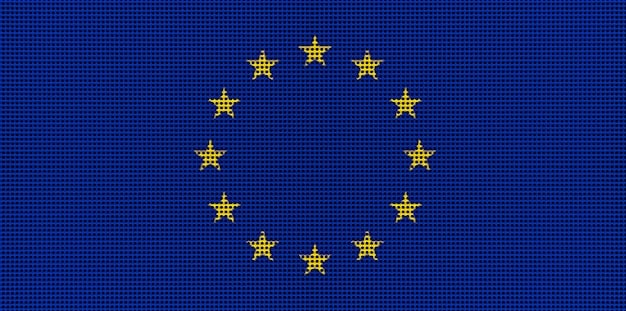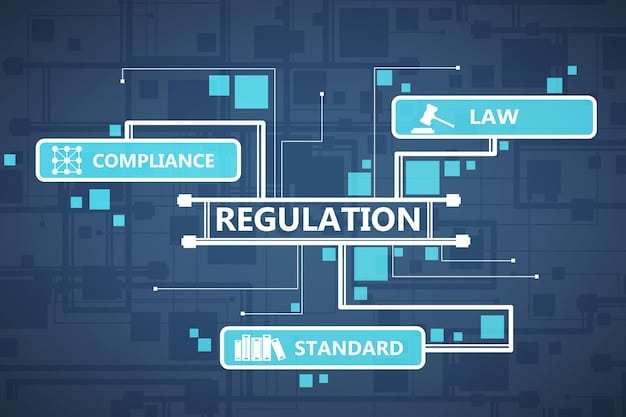EU Digital Services Act: US Tech Implications Unpacked

The European Union’s Digital Services Act significantly impacts US tech companies by imposing stringent regulations on content moderation, transparency, and platform accountability, necessitating substantial operational changes to comply with EU legal frameworks.
The digital landscape is rapidly evolving, with regulations attempting to keep pace with technological advancements. A cornerstone of this shift is the European Union’s Digital Services Act (DSA), a landmark piece of legislation with far-reaching consequences. For US tech giants, understanding what are the implications of the new EU Digital Services Act for US tech companies? is not just a regulatory hurdle, but a fundamental challenge to their global operations and business models.
Understanding the Digital Services Act (DSA) Fundamentals
The Digital Services Act, enacted by the European Union, aims to create a safer, more predictable, and trustworthy online environment. It is part of a broader regulatory push by the EU to assert its values in the digital sphere, complementing other significant legislation like the General Data Protection Regulation (GDPR). The DSA introduces a comprehensive set of rules for online intermediaries and platforms, ranging from small startups to the largest global tech companies.
At its core, the DSA targets illegal and harmful content online, while also protecting users’ fundamental rights. It seeks to balance the responsibilities of platforms with the freedoms of expression and information. The tiered approach of the DSA means that obligations increase with the size and systemic importance of the platform, placing unique burdens on very large online platforms (VLOPs) and very large online search engines (VLOSEs).
Key Pillars of the DSA
The DSA is built upon several critical pillars that define its scope and objectives. These pillars dictate how online services must operate within the EU, impacting everything from content moderation to transparent advertising practices.
- Harmful and Illegal Content: Establishes clear mechanisms for users to report illegal content and requires platforms to act swiftly.
- Transparency Obligations: Mandates platforms to be transparent about their content moderation practices, algorithmic recommendations, and advertising.
- Platform Accountability: Imposes stricter obligations on larger platforms concerning risk assessments and independent audits.
These pillars are not merely suggestions; they are legally binding requirements that can lead to significant penalties for non-compliance. For US tech companies, accustomed to a different regulatory environment, this necessitates a fundamental reassessment of their operational and compliance strategies within the EU market.
The DSA’s scope is broad, covering a wide array of online services. It differentiates between various types of intermediaries, applying different levels of obligation based on their function and scale. This nuanced approach means that US tech companies need to meticulously assess where they fit within the DSA’s framework and what specific responsibilities apply to them.
Operational Overhauls for US Tech Giants
The implementation of the DSA demands significant operational overhauls for US tech companies. These changes extend beyond mere policy adjustments, requiring substantial investments in infrastructure, personnel, and technological solutions. The sheer scale of these companies means that even minor tweaks can translate into massive undertakings.
One of the primary areas impacted is content moderation. The DSA introduces robust “notice and action” mechanisms, compelling platforms to respond promptly to reports of illegal content. This means US tech companies must enhance their systems for receiving, processing, and acting upon user notifications, often in multiple languages and across diverse legal jurisdictions within the EU.
Enhanced Content Moderation and Reporting
The new rules around content moderation are particularly stringent. Platforms must provide clear, easy-to-use mechanisms for users to report content they deem illegal or harmful. This isn’t just about removing content; it’s about providing detailed explanations to users when their content is removed or restricted, and offering effective complaint and redress mechanisms.
- Swift Response Times: Platforms must process notices promptly, sometimes within hours, depending on the severity of the content.
- User Appeal Mechanisms: Users must have the right to appeal content moderation decisions, leading to a significant increase in administrative burden.
- Trusted Flaggers: The DSA introduces “trusted flaggers,” entities with recognized expertise who can submit notices that platforms must prioritize.
These requirements necessitate scaling up content moderation teams, improving AI-driven moderation tools, and implementing more sophisticated review processes. The challenge is compounded by the need to understand specific national laws within the EU that define what constitutes “illegal content,” which can vary significantly across Member States.

Moreover, the DSA mandates clear terms and conditions that explain content moderation policies in accessible language. This means revising lengthy legal documents into user-friendly formats, ensuring transparency and understanding for the average user. Failure to do so can result in hefty fines, pushing companies to invest heavily in legal and communication resources.
Transparency and Accountability Requirements
Transparency is a cornerstone of the DSA, aiming to shed light on the often-opaque practices of online platforms. For US tech companies, this translates into unprecedented levels of disclosure, particularly concerning their algorithmic operations and advertising strategies. The goal is to empower users and regulators with more information to assess the fairness and impact of these platforms.
Platforms are now required to provide clear insights into their recommender systems. This includes explaining how these algorithms prioritize certain content over others and offering users choices regarding the factors used for recommendations. This level of algorithmic transparency is a significant shift, challenging the proprietary nature of many tech companies’ core technologies.
Algorithmic Transparency and Advertising Disclosure
The DSA mandates that platforms outline the main parameters used in their recommendation systems. This could involve disclosing the weight given to user engagement, content relevance, or other factors. Users must also be given the option to switch to a non-profiled recommendation system, giving them more control over their online experience.
- Clear Algorithmic Explanations: Platforms must publish accessible explanations of how their algorithms shape user feeds and content suggestions.
- User Choice for Recommendations: Users must have the option to opt out of personalized recommendations based on profiling.
- Ad Transparency: Advertisements must clearly identify that they are ads, who is paying for them, and how users are targeted.
Advertising transparency is another critical area. Platforms must ensure that users can easily identify commercial communications and understand who is responsible for them. This includes prohibiting hidden advertising and making it clear when content is sponsored. Targeting of advertising based on sensitive personal data (e.g., religion, sexual orientation) is also prohibited, as is targeted advertising to minors.
These transparency requirements extend to annual reporting. VLOPs and VLOSEs must publish annual reports on their content moderation activities, risk assessments, and compliance with the DSA. These reports must be comprehensive, providing insights into the volume of content removed, the reasons for removal, and the effectiveness of their systems. This level of public scrutiny is unprecedented and will require meticulous data collection and reporting mechanisms.
Very Large Online Platforms (VLOPs) and Very Large Online Search Engines (VLOSEs)
While the DSA applies to a broad range of online intermediaries, it imposes particularly stringent obligations on VLOPs and VLOSEs. These are defined as platforms with at least 45 million average monthly active recipients in the EU. Unsurprisingly, most major US tech companies fall into this category, meaning they bear the brunt of the DSA’s most demanding provisions.
The rationale behind this distinction is that these platforms, due to their size and reach, pose systemic risks to society. They can influence public discourse, disseminate disinformation, and facilitate illegal activities on a massive scale. Therefore, the DSA requires them to undertake additional responsibilities to mitigate these risks and contribute to a safer online environment.
Enhanced Obligations for VLOPs and VLOSEs
The obligations for VLOPs and VLOSEs go considerably beyond those for smaller platforms. They are required to conduct annual systemic risk assessments, identifying potential harms arising from their services and outlining measures to mitigate those risks. These assessments must cover areas such as the dissemination of illegal content, negative effects on fundamental rights, and intentional manipulation of their services.
- Systemic Risk Assessments: Regular, comprehensive assessments of risks related to their services’ design and functioning, including content moderation and algorithmic systems.
- External Audits: Mandatory independent audits of their compliance with DSA obligations, conducted by certified organizations.
- Data Access for Researchers: Providing access to their data for vetted researchers to investigate systemic risks.

Another significant obligation is the appointment of an independent compliance officer. This individual or team is responsible for monitoring the company’s adherence to the DSA and acting as a liaison with the European Commission and relevant national authorities. This adds another layer of internal oversight and accountability, placing a direct and significant burden on organizational structure.
Furthermore, VLOPs and VLOSEs must establish a crisis response mechanism, allowing them to react swiftly to significant incidents that pose risks to public security or health, or that involve the widespread dissemination of illegal content. This proactive approach to managing crises highlights the extensive responsibility placed on these platforms.
Impact on Business Models and Revenue Streams
The DSA is not merely a compliance exercise; it has the potential to fundamentally alter the business models and revenue streams of US tech companies, particularly those heavily reliant on targeted advertising and user data. The enhanced transparency requirements, coupled with restrictions on certain advertising practices, can directly impact profitability.
The prohibition on targeted advertising to minors and the limitations on using sensitive personal data for ad targeting mean that platforms will have to rethink their advertising strategies for the EU market. This could lead to a reduction in advertising effectiveness and, consequently, lower ad revenues. Companies may need to diversify their revenue streams or pivot towards less privacy-invasive advertising models.
Rethinking Monetization Strategies
The shift away from highly granular targeting requires advertisers to adapt, and platforms will need to provide new tools and services to meet these evolving needs. This could involve a greater emphasis on contextual advertising, where ads are relevant to the content being viewed rather than the user’s personal profile.
- Reduced Data Monetization: Limitations on user data use for profiling could decrease the value of user data for advertising.
- Increased Compliance Costs: Significant investments in legal, technical, and human resources for compliance will impact operating margins.
- Potential for Fines: Non-compliance can lead to fines of up to 6% of a company’s global annual turnover, posing a substantial financial risk.
Beyond advertising, the increased operational costs associated with DSA compliance will eat into profit margins. Hiring more content moderators, investing in new technologies for transparency, conducting regular audits, and maintaining reporting obligations all come at a considerable expense. These costs are a direct drag on profitability, potentially forcing companies to re-evaluate their investment priorities within the EU.
Moreover, the DSA introduces provisions for digital services coordinators in each EU Member State, who will be responsible for enforcing the act. This decentralized enforcement mechanism means US tech companies will have to navigate a complex web of national authorities, each with the power to investigate and impose sanctions. The cumulative effect of these compliance burdens could lead some companies to reconsider their presence or offerings in the EU market, or at least modify them significantly to align with the new regulatory reality.
The Broader Geopolitical and Regulatory Landscape
The DSA’s implications for US tech companies extend beyond immediate compliance challenges; they signal a broader shift in the global regulatory landscape. The EU has consistently positioned itself as a digital rule-maker, and the DSA is another testament to its ambition to set global standards for the digital economy. This has significant geopolitical ramifications, influencing how other countries approach digital regulation.
The “Brussels Effect,” where EU regulations become de facto global standards due to the size and importance of the EU market, is very much at play with the DSA. Companies might find it more efficient to implement DSA-compliant practices globally rather than maintaining separate systems for different regions. This could lead to a harmonization of digital regulations, even in countries without similar legislative frameworks.
Global Regulatory Convergence and Divergence
While the DSA might inspire similar legislation elsewhere, it also highlights potential divergences between regulatory approaches. The US, for instance, has traditionally favored self-regulation and a less prescriptive approach to content moderation and platform accountability. This philosophical divide can create friction and complex regulatory challenges for companies operating across both jurisdictions.
- “Brussels Effect” Expansion: EU regulations often set global precedents, potentially influencing digital laws in other nations.
- Regulatory Friction: Divergent regulatory approaches between the EU and US could create compliance complexities and legal uncertainties.
- Global Standard Setting: The DSA positions the EU as a leader in digital governance, pushing for a more regulated internet.
The DSA’s focus on platform responsibility and user rights is part of a broader global trend towards greater scrutiny of big tech. Governments worldwide are grappling with issues such as disinformation, online safety, and algorithmic bias. The EU, through the DSA, has provided a comprehensive model that many other jurisdictions will likely study and potentially emulate, or at least draw inspiration from.
Ultimately, the DSA compels US tech companies to confront fundamental questions about their role in society, their responsibilities to users, and their impact on democratic processes. It is a powerful statement about the power of regulation to shape the digital future, and it will undoubtedly influence strategic decisions and policy debates for years to come, not just within the EU, but across the entire global digital ecosystem.
| Key Point | Brief Description |
|---|---|
| ⚖️DSA Mandate | Aims for a safer online environment by regulating content moderation & transparency. |
| 🛠️Operational Overhauls | Requires significant investment in enhanced content moderation, reporting, and appeal systems. |
| 💸Business Model Impact | Limits on targeted ads and increased compliance costs affect revenue streams and profitability. |
| 🌍Global Influence | The DSA could set global standards, influencing regulations beyond the EU due to the “Brussels Effect.” |
Frequently Asked Questions (FAQ)
▼
The primary goal of the EU Digital Services Act (DSA) is to create a safer, more transparent, and accountable online environment for users. It aims to combat the spread of illegal and harmful content online while simultaneously protecting fundamental rights such as freedom of expression. By imposing clear responsibilities on online platforms, the DSA seeks to establish a predictable regulatory framework.
▼
The US tech companies most affected by the DSA are “Very Large Online Platforms” (VLOPs) and “Very Large Online Search Engines” (VLOSEs). These are platforms with 45 million or more active monthly users in the EU, typically including giants like Google, Meta (Facebook, Instagram), X (Twitter), Amazon, and Apple. They face the most stringent obligations due to their systemic influence.
▼
The DSA significantly impacts content moderation by requiring US tech firms to implement robust “notice and action” mechanisms, allowing users to easily report illegal content and mandating swift responses. It also demands transparent explanations for content removal decisions, user appeal processes, and cooperation with “trusted flaggers,” requiring substantial investment in both human and AI resources.
▼
The financial implications include substantial compliance costs for operational overhauls, increased personnel for content moderation, and investments in new technologies for transparency and data reporting. There’s also the potential for reduced ad revenue due to limitations on targeted advertising, particularly to minors, and significant fines of up to 6% of global annual turnover for non-compliance, posing a considerable financial risk.
▼
Yes, the DSA is highly likely to influence regulations in other countries, demonstrating the “Brussels Effect.” Given the EU’s significant market size, many global companies will find it more practical to implement DSA-compliant practices worldwide rather than maintaining separate systems. This could inspire similar legislative efforts globally, pushing for a more harmonized and regulated digital environment.
Conclusion
The European Union’s Digital Services Act represents a monumental shift in how online platforms, particularly US tech companies, must operate within the EU. It ushers in an era of heightened accountability, transparency, and responsibility, demanding significant operational adjustments from content moderation to algorithmic disclosure. For US tech giants, the DSA isn’t merely a new set of rules; it’s a redefinition of their relationship with users, regulators, and the fundamental principles of a safe and open internet. Navigating these complexities will require strategic foresight, substantial investment, and a willingness to adapt core business models to ensure compliance and maintain access to one of the world’s largest digital markets. The consequences of this regulation will resonate far beyond the EU’s borders, setting a precedent for digital governance across the globe.





